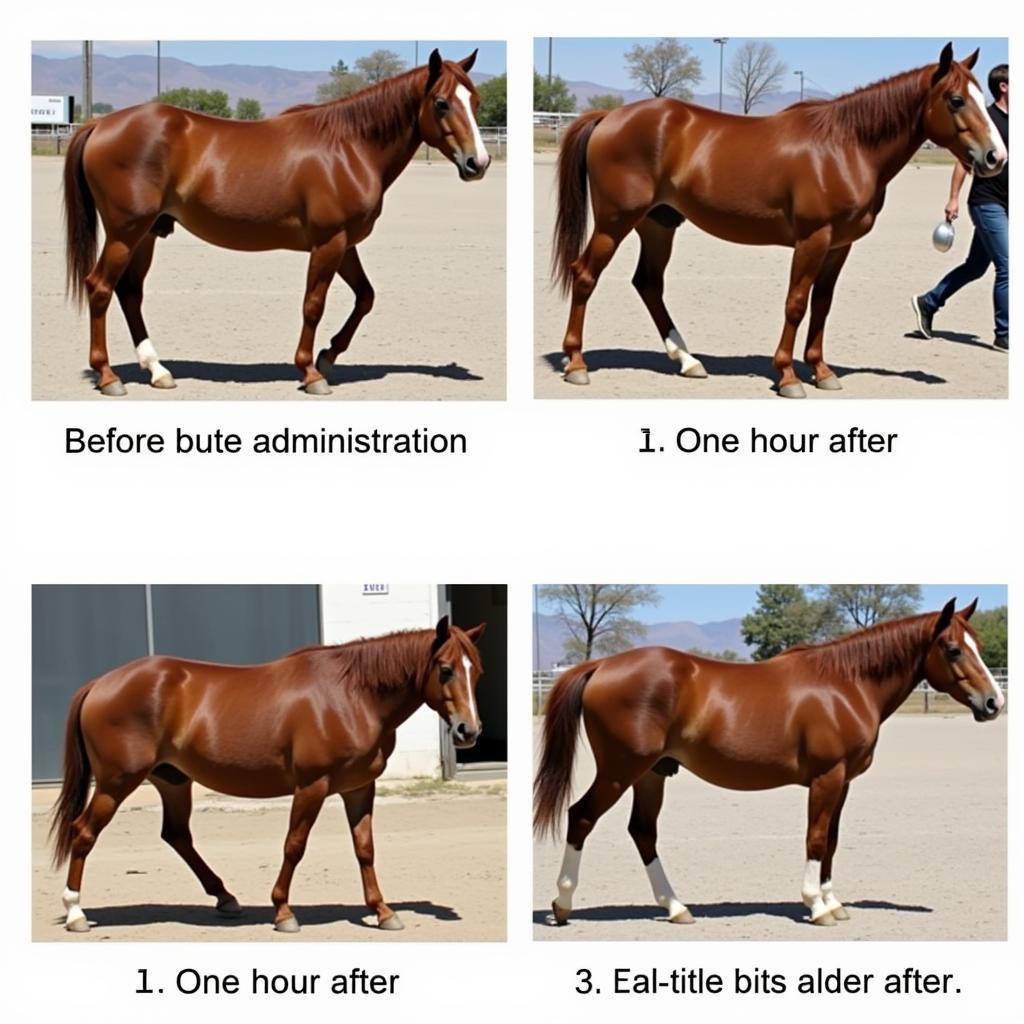Bute, short for phenylbutazone, is a common non-steroidal anti-inflammatory drug (NSAID) used to manage pain and inflammation in horses. Understanding how long bute takes to work in horses is crucial for effective pain management and ensuring your horse’s comfort.
Understanding Bute for Horses
Bute is often prescribed for conditions like osteoarthritis, laminitis, and musculoskeletal injuries. It works by inhibiting cyclooxygenase enzymes, which play a key role in producing prostaglandins, the compounds responsible for inflammation and pain. However, it’s important to use bute responsibly and under the guidance of a veterinarian. Overuse or improper dosage can lead to serious side effects. You might be interested in our article about blister stifles in horses for more information on related conditions.
How Bute is Administered
Bute can be administered to horses in several forms, including paste, powder, and tablets. The most common form is the oral paste, which is easy to administer directly into the horse’s mouth. Powdered bute can be mixed with feed, while tablets can be given whole or crushed and mixed with food. The chosen method often depends on the horse’s temperament and the specific situation.
 Bute Onset of Action in a Horse
Bute Onset of Action in a Horse
How Long Does Bute Take to Work in Horses: What to Expect
Typically, bute starts to take effect within 1-2 hours after administration. However, the peak effect, where the drug reaches its maximum concentration in the bloodstream, usually occurs within 4-6 hours. This means that the horse may not experience the full pain-relieving benefits until several hours after receiving the medication.
Factors Influencing Bute’s Effectiveness
Several factors can influence how quickly and effectively bute works in a horse:
- Dosage: The correct dosage is crucial for optimal pain relief. Too low a dose might not provide adequate pain control, while too high a dose increases the risk of side effects.
- Individual Metabolism: Just like humans, horses metabolize drugs differently. Some horses process bute more quickly than others, affecting the onset and duration of its effects.
- Severity of Condition: The severity of the underlying condition can also influence how quickly bute provides relief. Severe pain may require a higher dose or additional pain management strategies.
- Route of Administration: While oral administration is common, intravenous (IV) bute provides the fastest onset of action, as the drug enters the bloodstream directly.
“Bute is a powerful tool for managing pain in horses,” explains Dr. Emily Carter, DVM, “but it’s important to remember that it’s not a cure-all. Addressing the underlying cause of the pain is essential for long-term well-being.”
Monitoring Your Horse after Bute Administration
After administering bute, carefully monitor your horse for any signs of improvement or adverse reactions. Observe their movement, behavior, and appetite. While bute is generally safe, some horses may experience side effects such as gastrointestinal upset, ulcers, or kidney problems.
You may want to learn more about supplements for heaves in horses if you’re exploring other health concerns related to your horse.
Conclusion
Understanding how long bute takes to work in horses is essential for providing effective pain relief. While the initial effects may be noticeable within 1-2 hours, the full benefits typically take 4-6 hours. Always consult with your veterinarian to determine the appropriate dosage and monitor your horse for any potential side effects. Proper pain management, combined with addressing the underlying cause of the discomfort, is key to ensuring your horse’s health and happiness. You can explore our range of osteoform for horses for additional support.
FAQ
- Can I give my horse bute without a veterinarian’s prescription? No, bute should only be administered under the guidance of a veterinarian.
- What are the potential side effects of bute in horses? Potential side effects include gastrointestinal upset, ulcers, and kidney problems.
- How long can a horse stay on bute? The duration of bute treatment should be determined by your veterinarian based on the horse’s condition.
- Are there any alternatives to bute for pain management in horses? Yes, several other NSAIDs and pain management strategies are available. Discuss these options with your veterinarian.
- Can bute be given to pregnant mares? Bute should be used with caution in pregnant mares, as it can have potential adverse effects on the foal.
“It’s always best to err on the side of caution when it comes to medications,” advises Dr. Sarah Mitchell, Equine Specialist. “Consult with your vet regularly to ensure your horse’s treatment plan is appropriate and effective.”
Common Scenarios:
- Post-Surgery: Bute is commonly prescribed after surgery to manage pain and inflammation.
- Laminitis: Bute can help alleviate the discomfort associated with laminitis.
- Colic: While bute itself doesn’t treat colic, it can be used to manage pain associated with certain types of colic.
Further Resources:
- Check out our article on B Complete for horses for comprehensive nutritional support.
- Explore our collection of horse portraits paintings to celebrate the beauty of these majestic animals.
Need assistance? Contact us 24/7: Phone: 0772127271, Email: [email protected], Address: QGM2+WX2, Vị Trung, Vị Thuỷ, Hậu Giang, Việt Nam.